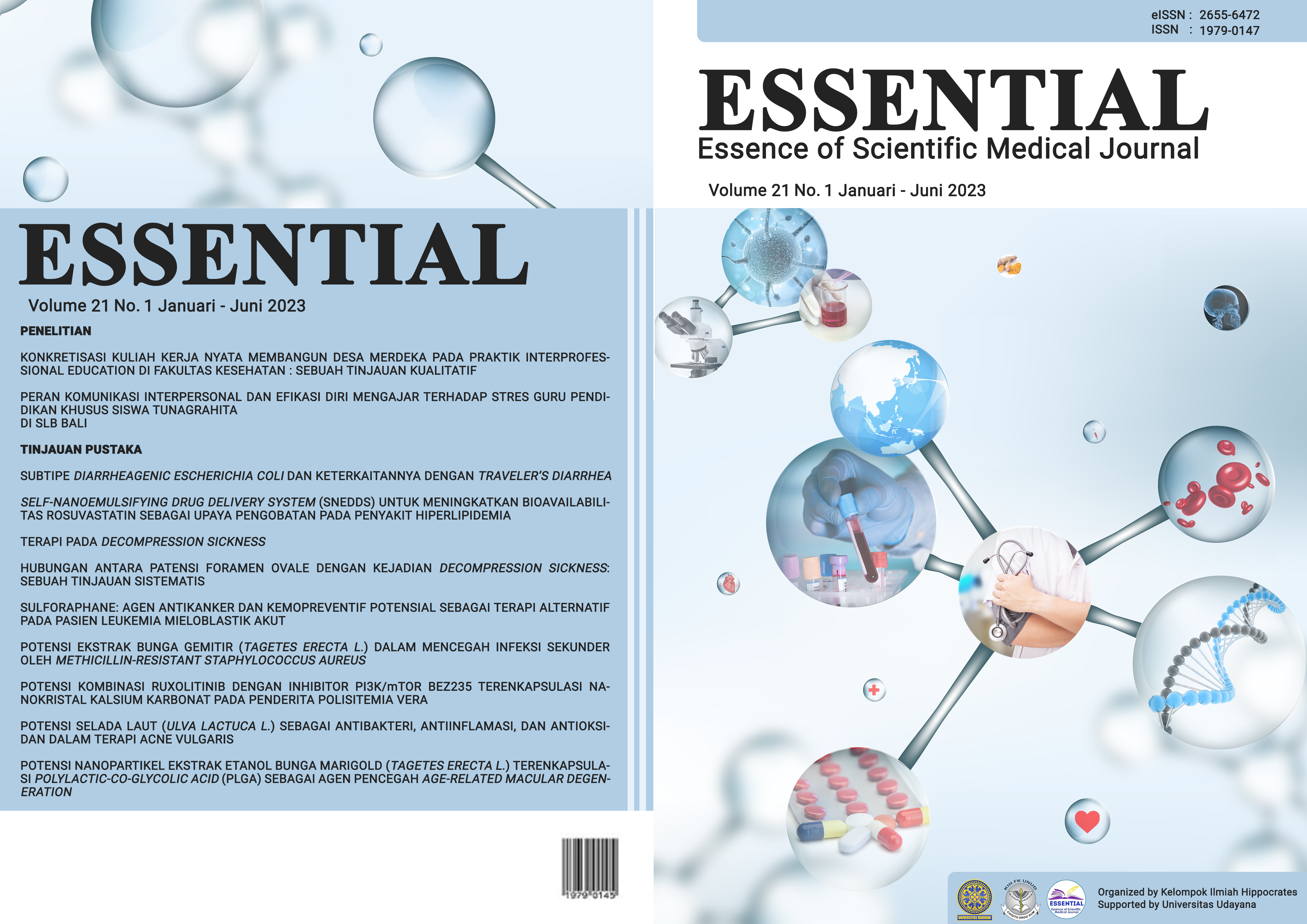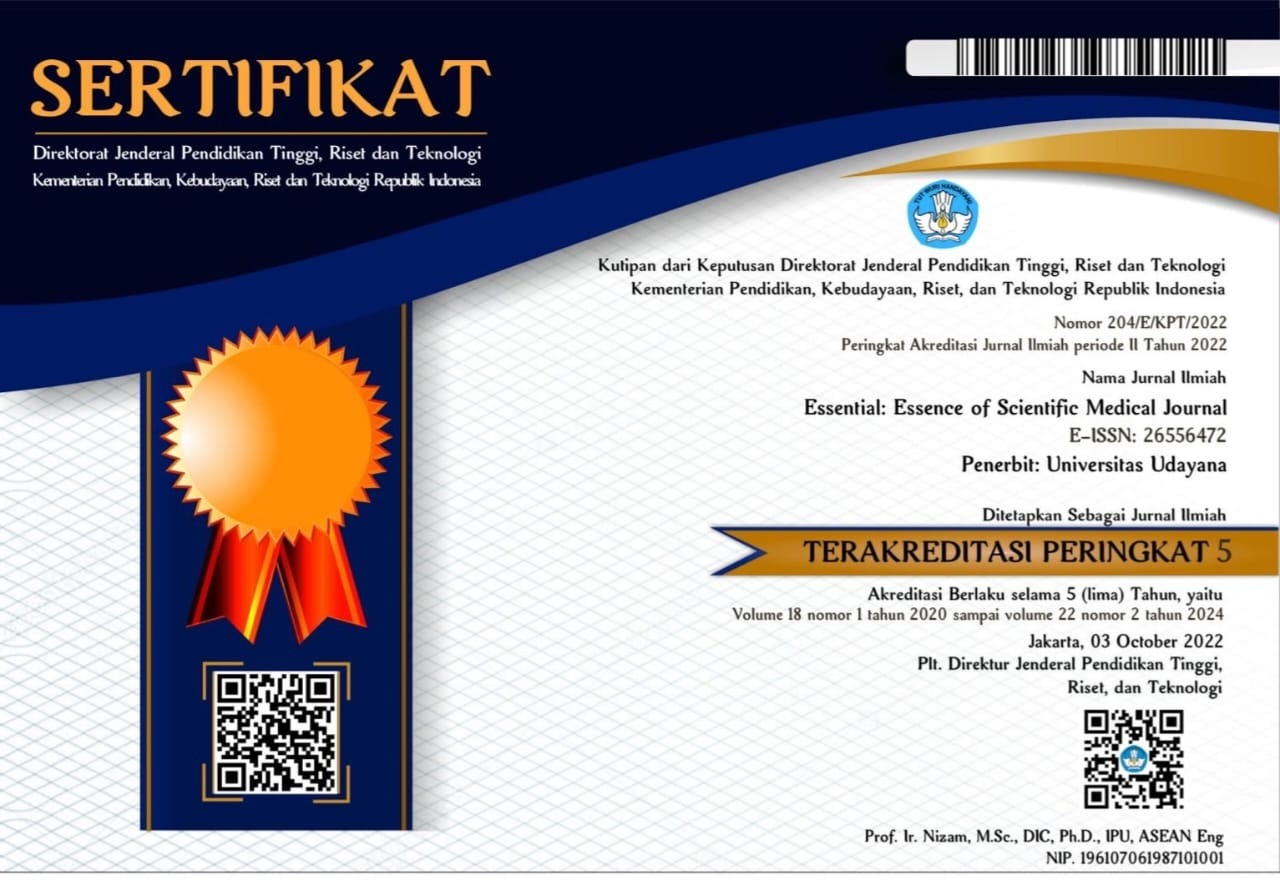HUBUNGAN ANTARA PANTENSI FORAMEN OVALE DENGAN KEJADIAN DECOMPRESSION SICKNESS
SEBUAH TINJAUAN SISTEMATIS
Abstract
Background: Decompression sickness (DCS) is a condition where bubbles form in the blood from dissolved gasses (usually nitrogen) which cause tissue and blood vessel injury due to a decrease in environmental pressure. One of the factors that can increase the incidence of DCS is the presence of patent foramen ovale (PFO) in divers.
Method: This literature review is a study systematic review, the type used is the original article obtained through the database PubMed and ProQuest. We use the keywords "decompression sickness," "divers with a patent foramen ovale," "divers without patent foramen ovale," and "risk" to find the articles. After tracing, a total of 303 articles were obtained and then sorted by taking into account the exclusion and inclusion criteria so that the final number obtained was two articles.
Results: :This systematic review, reviewed two studies with a total of 48 subjects.Patent foramen ovale (PFO) significantly related to the risk of occurrence of events decompression sickness (DCS). PFO closure reduces the risk of DCS events associated with PFO so that divers with PFO who have experienced DCS and undergo PFO closure, do not need to stop diving after intervention.
Conclusion: Divers with closed PFOs or closed shunts have a reduced risk of experiencing DCS. In these divers DCS is largely non-recurring, so they can return to dives indefinitely.
Downloads
References
[2] Pingitore A. Diver bubble self-monitoring with audio Doppler echography: a way to know own response to dive. Intern Emerg Med 2022;17:13–4. https://doi.org/10.1007/s11739-021-02888-5.
[3] Cooper, J.S. dan Hanson, K.C. (2022) ‘Decompression Sickness’, StatPearls [Preprint]. Available at: https://www.ncbi.nlm.nih.gov/books/NBK537264/ (Accessed: 3 April 2023).
[4] Lafère P, Balestra C, Caers D, Germonpré P. Patent Foramen Ovale (PFO), personality traits, and iterative decompression sickness. Retrospective analysis of 209 cases. Front Psychol 2017;8:1–7. https://doi.org/10.3389/fpsyg.2017.01328.
[5] Widyastuti SR, Hadisaputro S, Munasik M. Berbagai Faktor yang Berpengaruh Terhadap Kualitas Hidup Penyelam Tradisional Penderita Penyakit Dekompresi. J Epidemiol Kesehat Komunitas 2019;4:45. https://doi.org/10.14710/jekk.v4i1.4429.
[6] Honěk J, Šrámek M, Šefc L, Januška J, Fiedler J, Horváth M, et al. High-grade patent foramen ovale is a risk factor of unprovoked decompression sickness in recreational divers. J Cardiol 2019;74:519–23. https://doi.org/10.1016/j.jjcc.2019.04.014.
[7] Romano V, Gallinoro CM, Mottola R, Serio A, Di Meglio F, Castaldo C, et al. Patent foramen ovale—a not so innocuous septal atrial defect in adults. J Cardiovasc Dev Dis 2021;8. https://doi.org/10.3390/jcdd8060060.
[8] Oguntade AS, Oguntade MS. Patent foramen ovale closure review: decades of research and the evolution of the evidence. Egypt J Intern Med 2021;33. https://doi.org/10.1186/s43162-021-00059-8.
[9] Alakbarzade V, Keteepe-Arachi T, Karsan N, Ray R, Pereira AC. Patent foramen ovale. Pract Neurol 2020;20:225–33. https://doi.org/10.1136/practneurol-2019-002450.
[10] Honek J. Screening and Risk Stratification Strategy Reduced Decompression Sickness Occurrence in Divers With Patent Foramen Ovale 2021;15:162–71.
[11] Apostolos A, Drakopoulou. The management of patent foramen ovale in divers: where do we stand? Ther Adv Vaccines 2022;15:1–11. https://doi.org/10.1177/https.
[12] Koopsen R, Stella PR, Thijs KM, Rienks R. Persistent foramen ovale closure in divers with a history of decompression sickness. Netherlands Hear J 2018;26:535–9. https://doi.org/10.1007/s12471-018-1153-x.
[13] Edvinsson B, Thilén U, Nielsen NE, Christersson C, Dellborg M, Eriksson P, et al. Does persistent (Patent) foramen ovale closure reduce the risk of recurrent decompression sickness in scuba divers? Diving Hyperb Med 2021;51:63–7. https://doi.org/10.28920/dhm51.1.63-67.
[14] Anderson G, Ebersole D, Covington D, Denoble PJ. The effectiveness of risk mitigation interventions in divers with persistent (Patent) foramen ovale. Diving Hyperb Med 2019;49:80–7. https://doi.org/10.28920/dhm49.2.80-87.


 SUBMISSION
SUBMISSION
















